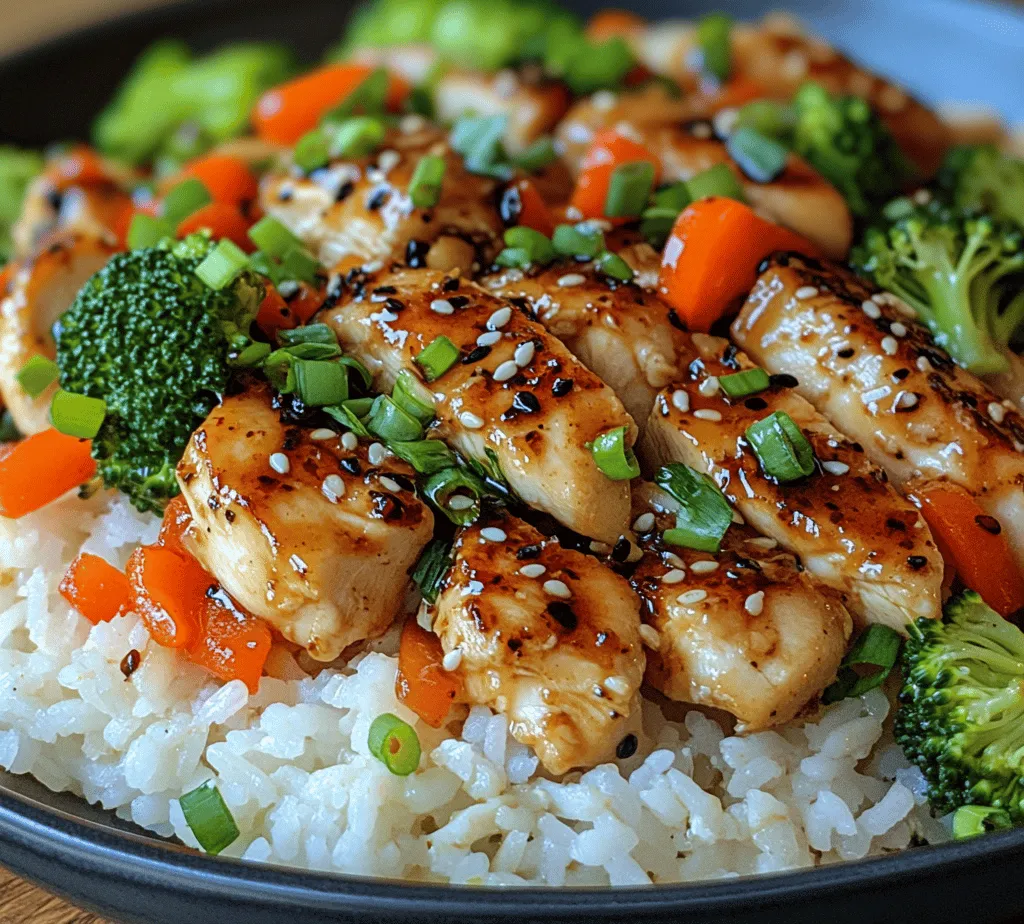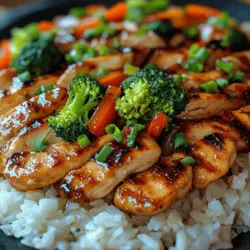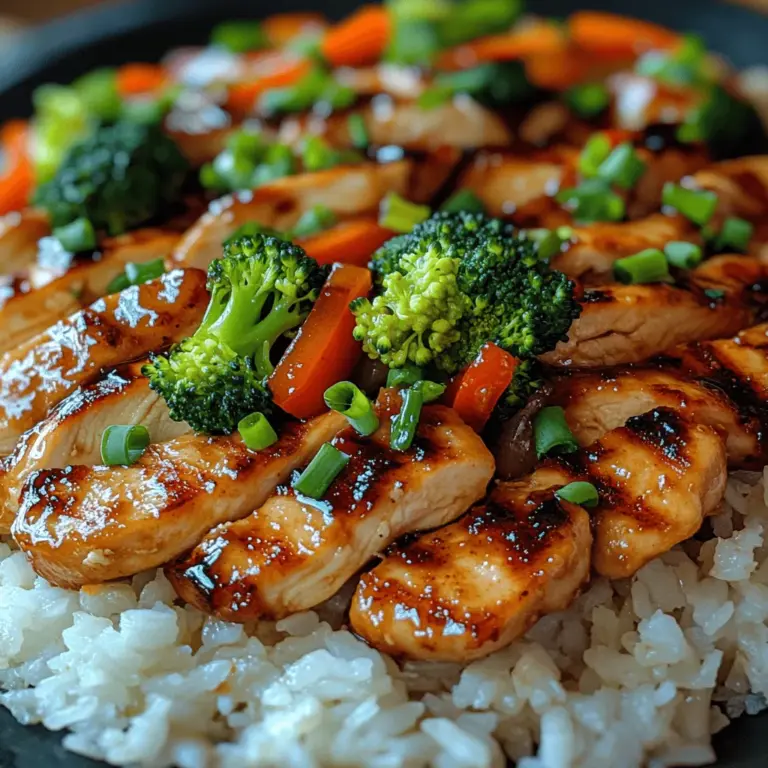Introduction
Stir-fry dishes have captured the hearts and taste buds of food lovers across the globe, becoming a staple in various cuisines, particularly in Asian culinary traditions. The appeal of stir-frying lies not only in its delightful flavors but also in its remarkable ability to deliver vibrant, colorful meals in a matter of minutes. In today’s fast-paced world, where time is often limited, a quick and easy chicken stir-fry emerges as an ideal solution for busy weeknights. This delicious dish allows you to whip up a wholesome dinner without spending hours in the kitchen.
One of the standout features of chicken stir-fry is its versatility. This dish can easily adapt to whatever ingredients you have on hand, whether it’s fresh vegetables from the farmers’ market or leftovers lurking in the fridge. Furthermore, by including a variety of fresh vegetables, you not only enhance the dish’s flavor and texture but also boost its nutritional value. With a colorful array of veggies, you can create a visually appealing meal that is as healthy as it is satisfying.
In this article, we will guide you through the fundamentals of creating a quick and easy chicken stir-fry, from understanding the basic cooking techniques to preparing a delicious, flavorful dish that can become a weeknight favorite for you and your family.
Understanding the Basics of Stir-Frying
What is Stir-Frying?
Stir-frying is a cooking technique that involves cooking food quickly in a small amount of oil over high heat while stirring constantly. This method originated in China, where it has been utilized for centuries. The technique allows for the rapid cooking of ingredients, preserving their colors, textures, and nutritional qualities. It is characterized by the use of a wok, which is designed for quick cooking and even heat distribution.
Historically, stir-frying was developed as an efficient way to prepare meals, making the most of limited resources and time. The process of stir-frying is not only about speed but also about maximizing flavor through high temperatures. The quick cooking time means that vegetables retain their crunch while proteins, like chicken, become tender and juicy.
Essential Tools for Stir-Frying
To achieve the best results in stir-frying, it’s essential to have the right tools on hand. Here are the key utensils you will need:
– Wok: The traditional choice for stir-frying, a wok has a rounded bottom and high sides, allowing for easy tossing and stirring of ingredients. Its shape promotes even heat distribution, which is crucial for proper cooking. If you don’t have a wok, a large skillet can also work effectively.
– Spatula: A wooden or silicone spatula will help you stir and flip ingredients without damaging your cookware. The long handle allows for safe maneuvering over high heat.
– Cutting Board and Knife: Sharp knives and a sturdy cutting board are essential for chopping your vegetables and chicken into uniform pieces, ensuring even cooking.
Importance of High Heat and Quick Cooking
The success of stir-frying relies heavily on high heat. Cooking at high temperatures quickly sears the ingredients, locking in moisture and enhancing flavors. This method is also vital for maintaining the crispness of vegetables, ensuring they don’t become soggy or overcooked.
When stir-frying, it’s important to have all your ingredients prepped and ready to go, as the cooking process happens rapidly. This preparation minimizes the risk of burning and helps you achieve perfectly cooked chicken and vegetables every time.
Ingredients Breakdown
For a delicious quick and easy chicken stir-fry, you will need the following ingredients, each playing a vital role in the overall flavor and nutritional profile of the dish.
Chicken Breast
Chicken breast is a popular choice for stir-frying due to its lean protein content and versatility. It is low in fat and high in protein, making it an excellent option for those looking to maintain a healthy diet. Additionally, chicken breast absorbs flavors well, making it the perfect canvas for savory sauces.
When preparing your chicken, consider cutting it into thin, uniform strips to ensure even cooking. Marinating the chicken before stir-frying can enhance its tenderness and flavor, creating a more enjoyable dining experience.
Soy Sauce and Oyster Sauce
Soy sauce is a staple in many Asian dishes, known for its rich umami flavor. It adds depth and saltiness to the stir-fry while enhancing the taste of the other ingredients. Oyster sauce, on the other hand, contributes a slightly sweet and savory profile, adding complexity to the dish. Together, these sauces create a harmonious blend of flavors that elevate the chicken and vegetables.
Cornstarch
Cornstarch may not be the first ingredient that comes to mind, but it plays a crucial role in the stir-fry process. When mixed with a bit of water and combined with the chicken, it helps to create a light coating that locks in moisture and tenderness during cooking. This technique, often referred to as “velveting,” ensures that your chicken remains juicy and flavorful.
Fresh Vegetables
One of the highlights of a chicken stir-fry is the colorful array of fresh vegetables. You can use a variety of vegetables, including bell peppers, broccoli, carrots, snap peas, and onions. Each vegetable brings unique flavors and textures to the dish, while also providing essential vitamins and minerals.
Incorporating a mix of vegetables not only adds visual appeal but also contributes to a well-rounded meal. Aim for a balance of colors to maximize the nutritional benefits and make your stir-fry more enticing.
Sesame Oil
Sesame oil is a flavorful oil often used in Asian cooking. It has a distinct nutty aroma and taste, which can enhance the overall profile of your stir-fry. A drizzle of sesame oil at the end of cooking can elevate the dish, giving it a rich finish that complements the other ingredients. Plus, sesame oil contains healthy fats that can contribute to heart health.
Cooked Rice or Noodles
To complete your chicken stir-fry, consider serving it over cooked rice or noodles. Both options make for a filling and satisfying meal. Brown rice offers more fiber and nutrients, while noodles provide a comforting base. You can choose from a variety of noodle options, including rice noodles, egg noodles, or even whole grain varieties, depending on your dietary preferences.
Preparation Steps
Step 1: Marinating the Chicken
Marinating the chicken is a crucial step that enhances both flavor and tenderness. To create a simple marinade, combine soy sauce, a bit of cornstarch, and a splash of sesame oil in a bowl. This mixture will coat the chicken, infusing it with flavor while ensuring it remains juicy during the cooking process.
To marinate, cut the chicken breast into thin strips and place it in the marinade. Allow it to sit for at least 15-30 minutes; if you have more time, marinating for a few hours in the refrigerator can yield even better results. This step not only enhances the taste but also helps to tenderize the meat, making your stir-fry a delicious and satisfying meal.
In the next part of this article, we will delve into the cooking process, providing you with a step-by-step guide to creating your quick and easy chicken stir-fry. Stay tuned to learn how to bring all these ingredients together into a flavorful and vibrant dish that’s sure to impress your family and friends!

Tips for Efficiently Chopping and Prepping Vegetables to Save Time
When it comes to preparing your chicken stir-fry, efficiency is key. Here are some tips to help you chop and prep vegetables quickly:
1. Use a Sharp Knife: A sharp knife not only makes chopping easier but also safer. Dull knives can slip and lead to accidents.
2. Prepare Ahead: Wash, peel, and chop your vegetables in advance. Store them in airtight containers in the refrigerator. This can save you valuable time on busy weeknights.
3. Batch Chopping: If you’re making stir-fry multiple times in a week, consider chopping larger quantities of vegetables and storing them. Vegetables like bell peppers, carrots, and broccoli can be prepped ahead and used in various dishes.
4. Uniform Sizes: Cut vegetables into uniform sizes to ensure even cooking. For example, slice bell peppers and onions in similar thickness to allow them to cook at the same rate.
5. Use Food Processors: If you’re short on time, a food processor can quickly chop vegetables. Just be careful not to over-process, as you want them to maintain some texture.
Techniques for Cooking Chicken Perfectly: Achieving the Right Texture and Doneness
Getting the chicken just right in your stir-fry is crucial for achieving a delicious dish. Here are some tips for perfect chicken preparation:
1. Choose the Right Cut: Chicken breast is commonly used for stir-fry because it cooks quickly and remains tender. However, thighs can offer more flavor and moisture.
2. Marinate for Flavor: A simple marinade can enhance the chicken’s flavor. Use soy sauce, garlic, ginger, and a splash of sesame oil for a delightful taste boost. Even a brief marination of 15-30 minutes can make a significant difference.
3. Cut Against the Grain: Slice the chicken against the grain to ensure tenderness. This method breaks down the muscle fibers and results in a juicier bite.
4. High Heat Cooking: Stir-frying requires high heat. Preheat your wok or skillet until it’s smoking hot before adding the chicken. This method helps to sear the meat quickly, locking in juices and preventing it from becoming dry.
5. Do Not Overcrowd the Pan: Cook the chicken in smaller batches to maintain temperature and achieve a golden brown sear. Overcrowding can lead to steaming instead of frying, affecting texture.
Sautéing Vegetables: Optimal Cooking Times for Maintaining Crunchiness and Color
Cooking vegetables in your stir-fry is about balance; you want them to be cooked but still retain their crunch and vibrant colors. Here’s how to do just that:
1. Order of Cooking: Start with heartier vegetables like carrots and broccoli, as they take longer to cook. Follow with softer vegetables like bell peppers and snap peas.
2. Quick Sauté: Generally, sauté vegetables for about 2-5 minutes. For a stir-fry, the goal is to keep them slightly undercooked, as they will continue to cook from residual heat after being removed from the pan.
3. Use a Splash of Water: If you notice your vegetables starting to stick or dry out, add a splash of water or broth. This will create steam and help them cook quickly without losing their crunch.
4. Color and Texture: Keep an eye on the color; vibrant greens and bright reds indicate that your vegetables are perfectly cooked. If they start to lose their color, they may be overcooked.
Cooking Techniques for a Perfect Stir-Fry
Temperature Control: The Significance of High Heat in Stir-Frying
High heat is essential in stir-frying to ensure that food cooks quickly and retains its flavor, texture, and nutritional value. When the cooking surface is hot enough, it sears the food, creating a beautiful caramelization that enhances the dish’s overall taste.
1. Preheating: Always preheat your wok or skillet for several minutes on high heat before adding oil and ingredients. This step ensures that the oil heats quickly and prevents sticking.
2. Oil Selection: Use oils with high smoke points, such as vegetable oil, canola oil, or peanut oil. These oils can withstand the high temperatures needed for stir-frying without burning.
3. Temperature Management: If you notice the food is browning too quickly or starting to burn, lower the heat slightly. However, always aim to keep the pan hot to maintain the stir-fry’s speed and quality.
Importance of Batch Cooking: Why It’s Better to Cook in Smaller Portions
Cooking in batches is a fundamental technique for achieving a successful stir-fry. Here’s why:
1. Even Cooking: Cooking smaller portions allows for better heat distribution. This ensures that each piece of chicken and vegetable cooks evenly and thoroughly.
2. Reduced Steaming: When too many ingredients are in the pan, they release moisture, leading to steaming rather than frying. This can result in soggy vegetables and rubbery chicken.
3. Flavor Development: Cooking in smaller batches enhances the caramelization process, leading to more depth of flavor in your dish. Each ingredient gets the chance to sear properly, creating a delightful contrast of textures.
Combining Ingredients: How to Achieve a Harmonious Blend of Flavors and Textures
When creating a stir-fry, the way you combine and layer your ingredients can greatly affect the final result. Here are some techniques to consider:
1. Layering Flavors: Start with aromatics like garlic and ginger, then add protein, followed by vegetables. This sequence allows each component to release its flavors and blend beautifully.
2. Sauce Consideration: Add sauces near the end of cooking to prevent burning. This timing allows you to coat the ingredients evenly without losing the sauce’s intensity.
3. Add Fresh Herbs Last: If you’re incorporating fresh herbs or delicate greens (like spinach), add them at the very end of cooking. This will keep them vibrant and add a fresh note to the dish.
Serving Suggestions
Plating your stir-fry attractively can elevate your meal experience. Here are some ideas to enhance presentation and flavor:
1. Plate with Care: Use a large, shallow bowl or plate to showcase the stir-fry. Start with a base of rice or noodles, then top with your chicken stir-fry mixture. This layering creates an appealing visual contrast.
2. Garnishes for Appeal: Fresh garnishes can brighten your dish. Consider adding sesame seeds, chopped scallions, or fresh cilantro on top right before serving. These not only add flavor but also enhance the visual appeal.
3. Variations for Customization: Stir-fry is incredibly versatile. Feel free to explore adding nuts like cashews or peanuts for crunch, or switch up the protein with beef, shrimp, or tofu. You can also experiment with different sauces such as teriyaki or sweet and sour.
Nutritional Information
Understanding the nutritional content of your stir-fry can help you make healthier choices. Here’s a breakdown of what you can expect per serving:
– Calories: Approximately 350-400 calories, depending on the ingredients used.
– Protein: Roughly 30 grams of protein, making it a great option for muscle maintenance and repair.
– Carbohydrates: About 40 grams of carbohydrates, primarily from the vegetables and any rice or noodles.
– Fats: Approximately 10 grams of fat, mostly from the oil used in cooking.
This chicken stir-fry aligns well with healthy eating habits by incorporating a variety of colorful vegetables. The inclusion of chicken provides lean protein, while the vegetables contribute essential vitamins and minerals.
Incorporating more vegetables into your daily meals not only enhances your nutrient intake but also promotes overall health. Aim to fill your plate with a rainbow of colors to maximize the benefits.
Conclusion
In summary, the quick and easy chicken stir-fry recipe is a superb choice for those seeking a delicious, nutritious, and versatile meal. The simplicity of preparation combined with a variety of ingredients allows for endless customization to suit individual tastes and dietary preferences.
Stir-fry dishes are not just quick; they can be a canvas for creativity in the kitchen. Don’t hesitate to experiment with different proteins, sauces, and vegetables to discover new flavor combinations. Whether you’re cooking for yourself or entertaining guests, this dish is sure to impress.
Encourage yourself to embrace the stir-fry method in your cooking routine, allowing you to enjoy flavorful meals that are also healthy and satisfying. Happy cooking!


